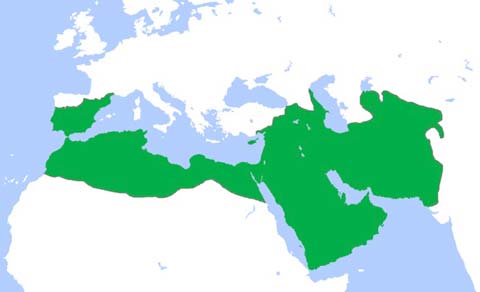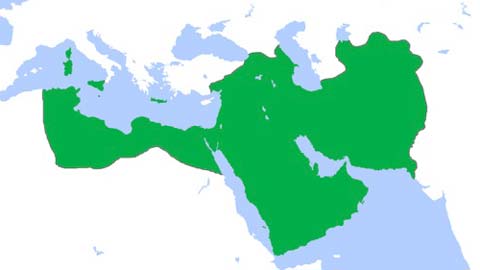- Trending:
- Pope Leo Xiv
- |
- Israel
- |
- Trump
- |
- Social Justice
- |
- Peace
- |
- Love

RELIGION LIBRARY
Islam
Exploration and Conquest
When the Prophet Muhammad's cousin and son-in-law Ali was killed in 661, the Age of the Rashidun, or rightly-guided ones, came to an end. Mu'awiyah, a member of the powerful Umayyad clan and governor of Syria, assumed the office of caliph and moved the capital of Islam from Medina to Damascus. This marked the beginning of the Umayyad Caliphate, which ruled the Islamic world until 750. By appointing his son Yazid as his successor, Mu'awiyah founded the tradition of family dynasties, which effectively ended the original Islamic practice of electing the caliph by a council of elders, or shura.

Throughout their reign, the Umayyad caliphs faced civil war and rebellion, but maintained their dominance and engaged in a spectacular campaign of territorial expansion. Before the founding of the Umayyad Caliphate, Muslim armies had already occupied what are today Syria, Egypt, Libya, Iraq, and Iran. In the first part of the 8th century, Umayyad forces completed the conquest of north Africa, Spain, and Portugal, and invaded territories as far east as central Asia, Afghanistan, and India. Poetry, art, and architecture thrived under Umayyad rule, as did scholarship and trade. Arabic was the official language of the government and of religion, and Arab settlers traveled far and wide.
| Major Muslim Dynasties | ||
| "Age of Rashidun" | capital in Medina | 632-661 |
| Umayyad Caliphate | capital in Damascus | 661-750 |
| Abbasid Caliphate | capital in Baghdad | 750-1258 |
The Umayyad dynasty fell over the issue of taxes. The small ruling class paid lower taxes, while the lower classes and minority non-Muslims paid higher taxes. For a short while, the Umayyads even discouraged conversion to Islam in order to maintain higher tax revenue. Resentment turned into rebellion, and descendants of al-Abbas, an uncle of the Prophet Muhammad, raised an army in northern Iran. The Abbasids defeated the Umayyad army and killed many of the Umayyad leaders, winning the caliphate for themselves.

The Abbasids moved the capital from Damascus to Baghdad, and ruled the Islamic world from 750-1258. After a century or so of quelling uprisings and solidifying control, the Abbasid Caliphate oversaw an era of prosperity and cultural achievement. Industry, agriculture, and commerce all flourished, while Baghdad became an international trade center with a population of nearly a half-million. This wealth funded research in math, science, medicine, architecture and art, poetry, literature, and philosophy. Muslim cities became important centers of learning where Greek and Latin works of science and philosophy were translated, interpreted, revised, and recast to fit an Islamic world view.  Cross-cultural exchanges, particularly in science and art, enriched Islamic civilization and neighboring civilizations alike. Christian scholars in Europe studied the work of Muslim scholars, who brought sophisticated mathematics and science, and the translations of Greek and Latin scholarship, to the European cities and schools.
Cross-cultural exchanges, particularly in science and art, enriched Islamic civilization and neighboring civilizations alike. Christian scholars in Europe studied the work of Muslim scholars, who brought sophisticated mathematics and science, and the translations of Greek and Latin scholarship, to the European cities and schools.
The Abbasids ruled directly over Mesopotamia, Iran, Egypt, and Syria, and collected taxes and tributes from the more distant provinces. In the late 9th century, Morocco, Tunisia, Syria, and Iran won autonomy from the Abbasid Caliphate. Changes in leadership in Egypt and Baghdad contributed to growing dissension, weakening the power of the central government. In the late 11th century, Abbasid armies were attacked in the west by invading Christian Crusaders and in the east by Mongol forces. The Mongols captured Baghdad in 1258, and executed the last Abbasid caliph. This event marked the end of the Islamic caliphates.
There were other Islamic empires after 1258, but no single empire after the Abbasids extended its influence throughout the whole Islamic world. The end of the Abbasid Caliphate was thus an important watershed in Islamic history, marking the end of the era of Muslim political unity. Some Muslims still look forward to a time when Muslim political unity could be restored.

Often called the jewel of the western Islamic Empire, the Caliphate of Andalusia (in modern Spain) survived for two more centuries after the end of the Abbasid Caliphate, although losses to Christian armies began eroding the Spanish caliphate's territorial unity in the 12th century. At its peak, in the 9th - 10th centuries, the Andalusian Caliphate boasted a wealthy and diverse population. Commerce, science and mathematics, the arts, and learning all flourished, making Muslim Spain a symbol for some of the most acclaimed aspects of Muslim culture, including architecture, libraries, literature, and scientific innovation. The last of the Spanish Muslim kingdoms, in Granada, fell in 1492 to the forces of King Ferdinand and Queen Isabella, who expelled the Muslim population and appropriated Muslim property. The legacies of the Spanish Caliphate and the Ottoman Empire suggest that Islam, far from being a foreign element in Europe, is an integral part of European history and culture.
kingdoms, in Granada, fell in 1492 to the forces of King Ferdinand and Queen Isabella, who expelled the Muslim population and appropriated Muslim property. The legacies of the Spanish Caliphate and the Ottoman Empire suggest that Islam, far from being a foreign element in Europe, is an integral part of European history and culture.
Over the centuries, other Islamic empires also ruled over specific geographical areas. While each of these empires made a distinctive contribution to world history as well as to Islamic life and culture, none of them commanded the allegiance of Muslims everywhere. The wealthy Mughal Empire ruled most of the Indian subcontinent from the 16th to 18th centuries. When the Mughal Empire fell into decline, the British Empire used the opportunity to take control of India. The British exiled the  last Mughal ruler in 1857.
last Mughal ruler in 1857.
In Iran, the Shi'i Safavid Dynasty ruled from 1501 to 1722, at times controlling additional territory in Iraq and central Asia. The Safavid rulers aggressively campaigned to convert all Muslims to the Twelver sect of Shi'ism, and were largely successful. Today, roughly 90 percent of Iranians are Shi'i Muslim. At its peak, the Safavid Dynasty promoted advanced engineering, city planning, scholarship, and architecture and the arts. Shi'i scholars from Arab countries were recruited to teach in Iran. These scholars received control of Iran's educational and legal system, and assumed the religious duties of government. While Shi'i doctrine suggested that the religious scholars were the rightful leaders of the community, the scholars accepted Safavid rule.
The Safavid Dynasty fell due to its own internal decline. The economy fell into ruin, and incompetent leadership was unable to respond to the challenges. The Safavid Dynasty was ultimately replaced by the much weaker Qajar Dynasty, which fell in 1921 to a military strongman, Reza Khan, who founded the Pahlavi Dynasty. The Pahlavi Dynasty was also short-lived, falling to popular uprisings led by the Ayatollah Khomeini. The Iranian Revolution of 1979 resulted in the founding of the Islamic Republic of Iran.
In Egypt, the Mamluk State ruled Egypt, Syria, western Arabia, and parts of Asia Minor from 1250 to 1517, when Mamluk armies were defeated by armies of the Ottoman Empire. The Ottoman Empire was founded by Muslim Turks from central Asia, and at its peak, controlled territory in southeastern Europe, northern Hungary, the Middle East and Iran, and most of north Africa. The Ottoman Empire ruled from the early 14th century until its defeat in World War I. After the war, Britain, France, Italy, and Russia carved up Ottoman territory and divided it amongst themselves. Only Turkey emerged as an independent nation.
Study Questions:
1. How did the rule of the Umayyad contribute to the spread of Islam?
2. How was faith politicized under the Umayyad rule? Was conversion a driving force?
3. What did the Abbasid empire contribute to the Muslim world?
4. How was Islam’s success tied to wealth?










